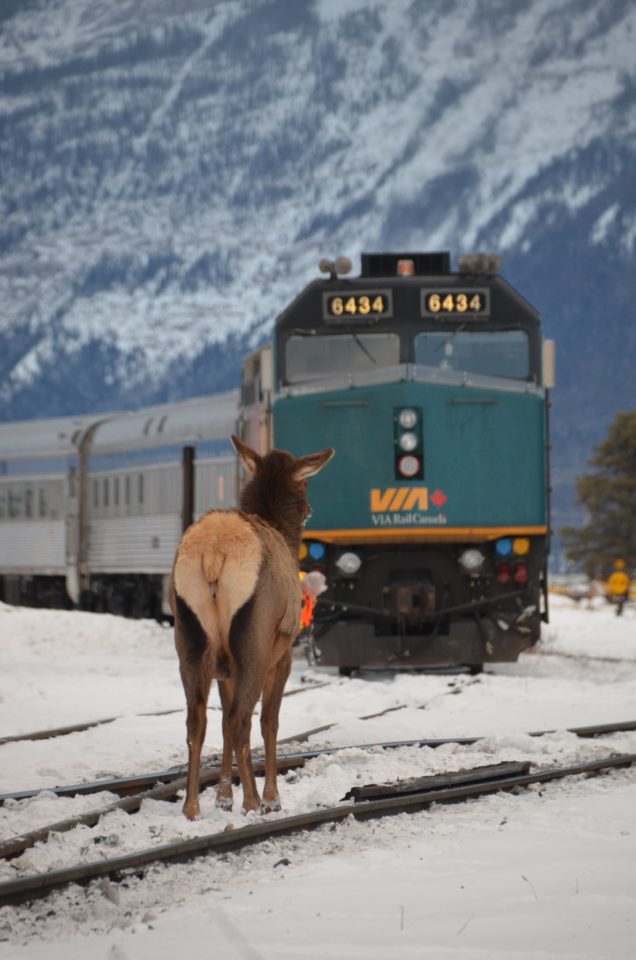by Marissa Lorenz
Residents of Kremmling and beyond have commented recently on what seems to be a large number of elk deaths occurring on nearby train tracks. One local landowner reported at least six incidents adjacent to their property where elk will feed with the horses and then sleep on the railroad tracks. And when tallied during a recent survey, counts of elk and other animal carcases certainly do start to add up.
Last week, a Colorado Parks and Wildlife (CPW) officer accompanied a Union Pacific Railroad employee along the tracks between Hot Sulphur Springs and Rancho del Rio, along the Trough Road, south of Kremmling, in order to collect regularly-measured data on wildlife-train collisions in the area.
Among the counted remains were 87 elk, 39 deer, 3 eagles, 1 bobcat, and a number of domestic dogs.
John Behncke, District Wildlife Manager for CPW’s Hot Sulphur District, indicates that such animal-train collisions are not unusual, but notes that their numbers frequently depend on the severity of winter. He says that, in comparison, only a few elk collisions were reported along the same section of track last year, “less than 10, or maybe even 5.”
Behncke explains that a large part of the collisions occur between Byers Canyon and Kremmling, an area considered to be “critical winter range” and through which animals will pass to get out of deep snow and into the river bottom for food, like sage, and water.
Local railroad workers report a similar observation, that there are always more animal injuries and fatalities when the snowpack is deeper, such as this year, following heavy snows in January. And the problem of collisions is actually exacerbated by the fact that the Railroad plows the tracks to ensure passage of their trains.
“It makes an easy route for animals to walk along,” explains Behncke, “and the right-of-ways on either side of the tracks, not used for either recreational or agricultural purposes, often have higher grasses that are ideal for elk and deer to feed on.”
And if a train comes upon them, well, Behncke says, there’s a reason the expression “like a deer in headlights” exists in our language. The animals are often too stunned to move out of the way in time, and when they are left on the tracks, dead or dying, they attract other scavenging animals–accounting for the eagles, wildcats, and dogs.
Behncke reports that local Union Pacific (UP) workers are often the most helpful in both reporting and responding to a call when a collision occurs. He says that he has ridden out with them numerous times this year alone to deal with injured animals and that they will do their best to move carcasses away from the tracks, particularly in an attempt to reduce collisions with eagles.
Behncke also says that there are limited alternatives that could help reduce the wildlife-train collisions. “The UP does spray the vegetation and weeds close to the tracks to reduce the available fodder, but they cannot spray further because of private land and agricultural activities.”
He describes some historic efforts focused on drawing animals away from the tracks, such as plowing other tracks through deep snow to divert animals to another location and/or feeding efforts that lead animals to eat at a safe distance
And Behncke indicates that he has heard that engineers familiar with the area will often slow down during heavy snow years. “More slow down could also alleviate the number of collisions,” Behncke suggests.
But Behncke says that the easy pathway offered by plowed railway tracks will always provide an obvious route for migrating animals.
He points to historic data that shows the problem is long-standing. Annual surveys of pelvic counts have been conducted since the 1950s. And when Behncke retrieves those numbers, they show that deer pelvises found along the tracks between Byers Canyon and Sulphur Gulch, just east of County Road 2–a much smaller section of the recently-surveyed route–averaged 80 deer a year from the 1950s through 2010.
That is twice as many deer that were counted in last week’s survey along the length of the West Grand County railway tracks and almost the equivalent of the full animal count. But as Behncke points out, it’s still early in the season and the data being compared is from different sections, at different times, and of different survey objects. “It’s all like comparing apples to oranges,” he reminds.
For more information on wildlife in Colorado, visit Colorado Parks and Wildlife online at cpw.state.co.us or in person at the Hot Sulphur District Office, located near the west end of Byers Canyon.









